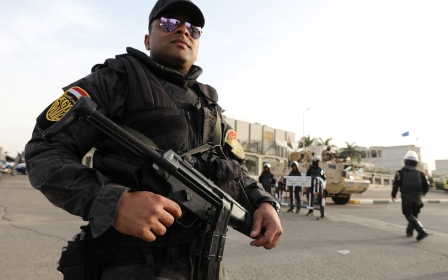How Sisi and the Islamic State both benefit from sectarian violence

In the 18-day uprising in Tahrir square in 2011, I witnessed the peak of unity between Egypt’s Muslims and Coptic Christians.
It had been only a few days after the New Year’s Eve suicide bombing at a church in Alexandria had killed at least 23 people leaving midnight mass. But in Tahrir, I saw Copts joining hands to protect dozens of Muslims kneeling in prayer as Mubarak’s security forces and thugs anxiously stood by, ready to attack them.
After large-scale protests broke out, the Mubarak regime was already crumbling when the Egyptian media leaked documents showing that Mubarak’s interior minister, Habib al-Adly, had masterminded the deadly attack in order to blame it on Islamists.
Adly’s grand plan was to justify intensifying the crackdown on the Muslim Brotherhood, which had grassroots popularity, and use the group as a scarecrow to gain further Western support for the ageing regime facing increasing dissent.
In Tahrir square, I met several Christian protesters who believed in this narrative, blaming the government for either masterminding, colluding or facilitating in one way or another various attacks that fomented sectarianism and ultimately fed its divide-and-rule agenda.
For that reason, Muslims and Christians were fighting the government toe-to-toe, believing that overthrowing the regime would bring an end to the nightmares of terrorism and sectarianism.
During the 18 days of the uprising, despite the police absence across the country, there was not one single sectarian crime against Christians.
Strongman or sectarian incubator?
This kind of climate of tolerance has appeared rarely in Egypt in the past – for example, during the 1919 struggle for freedom when both Christians and Muslims fought arm-in-arm against the British occupation.
In this sense, the stability that some believe is guaranteed by a strongman actually proves to be a perfect incubator for sectarianism and terrorism, especially in a country that witnessed a spark of freedom gained by the uprising. Creating an enemy always entrenches repressive powers.
Sisi’s main focus at the moment is not to fight terrorism or to protect Christians, but rather to ensure that he will remain in power for a second term
Consider President Abdul Fattah al-Sisi of Egypt as an example of this. Or Recep Tayyip Erdogan of Turkey. Or King Salman of Saudi Arabia. There is always an enemy for these leaders - the Muslim Brotherhood described as “evil people” or the Gülen movement or Iran.
For Sisi, despite his huge capabilities in terms of military equipment and personnel, a stable government, and a repressed opposition that keeps a low profile, yet any effort to fight terrorism leads to an exacerbation of the crisis, with a domino effect on the economy and living conditions of the public.
As was said in a US congressional hearing last month, Sisi’s main focus at the moment is not to fight terrorism or to protect Christians, but rather to ensure that he will remain in power for a second term - and probably forever. To achieve that, he has to make sure that the uprisings of 2011 will never, ever happen again.
Working as a journalist in Egypt from 2002 until 2014, I covered several incidents in which Muslims attacked Christians or churches in disfranchised, impoverished villages in the south. No one stood for trial. In many cases that I covered, police didn’t bother to investigate or press parties to reconcile. On other occasions, Christians fled their villages and homes for the north or overseas.
Here, in front of the Maspero television building, constructed in the 1960s to be a mouthpiece of Nasser’s one-voice era, I saw for the first time in my career a direct confrontation between the government, led by the military junta (SCAF), and peaceful Christians who were protesting against the government’s demolition of a church in Aswan province, southern Egypt, and its subsequent mishandling of the situation.
At a time when Christians make up as much as 18 percent of Egypt’s 90 million population, there are 2,896 churches in the country, compared with 108,395 mosques.
I still remember dozens of people rushing to the scene from surrounding slums, taking the military’s side after they heard the state media report that Christians had opened fire on the army.
After a brief democratisation transition that ended with the military coup against president Mohamed Morsi in July 2013, Egypt has been plagued by both an authoritarian regime and Islamic State, which are the only beneficiaries of the sectarian violence in the country.
Targetting Libya?
It is ironic that Sisi’s response to the escalating sectarian attacks by the Islamic State affiliate in Egypt is completely irrelevant to the crimes committed.
Following the deadly blasts on Tanta and Alexandria churches that killed 45 Egyptian civilians in April, Sisi imposed a state of emergency, which proved to be a failure, when 29 Copts, travelling to a monastery, were killed in Minya province on 26 May after gunmen dressed as soldiers fired on their convoy.
In the month between the two attacks, instead of protecting Egyptians, the state of emergency was used to intensify the crackdown on civil society actors, including blocking 20 news websites and arresting a human rights lawyer, Khaled Ali, a prominent activist who is running for the presidency next year.
In the aftermath of the attack in Minya, located in the heart of Egypt, Sisi immediately responded by launching several air strikes on Derna, a port city in eastern Libya which is almost 1,500km away – while the real perpetrators escaped the scene.
The inconsistency of the air strikes with the attack on Egypt’s mainland suggests that the air strike was previously planned and simply awaiting justification - like the Minya attack.
By the time the Islamic State (IS) group claimed responsibility for killing the Egyptian civilians in Minya, the air strikes had targeted airbases of the Mujahideen Shura Council in Derna (MSCD), a Libya-based al-Qaeda affiliate which denied any involvement in the attack. This is the same group which retook Derna after defeating IS fighters last year.
The irrelevance of the al-Qaeda affiliate in Libya to the Minya attack suggests that the Egyptian military is weakening a group that fights IS for the benefit of the Libyan National Army, led by a leader in Sisi’s image, retired military officer Khalifa Haftar.
Of course, this isn't to say that terrorists like IS shouldn't be held accountable for their acts against Christians in Egypt which are clearly meant to destablise the county and foment sectarian violence. But Sisi has failed to deal with the crisis head on and that is the issue.
A golden opportunity
In a US Congressional hearing in Washington two months ago, there was a unanimous agreement about revising US assistance to Egypt, which takes the form of equipment worth $1.3bn annually. The main argument focused on Sisi’s disinterest in participating in the US- led coalition fighting IS in Syria and Iraq.
The Minya attack is a golden opportunity for Sisi to show that he is using US made F-16 jets in cross-border counter-terrorism operations. The message is that Egypt is proactive and deserves full military aid.
With all signs suggesting that a new attack would target Christians, why didn’t the Egyptian government secure the bus in Minya with even a single police car?
Meanwhile, the frequency of attacks against Christians will garner international backing, especially from Washington, while turning a blind eye to the government’s increasingly repressive policies and human rights violations, procedures Sisi must take to prepare to run for re-election next year.
For the first time in front of an Egyptian audience, Sisi urged US President Trump in a televised speech in the aftermath of Minya attack to fight terrorism. “I call on the US president Trump, I trust you, your words and your ability that your priority is countering terrorism all over the world. I am confident Mr President that you will achieve this goal,” Sisi said in his speech.
This call has two interpretations: either Sisi needs Trump’s thumbs-up for his cross-border strikes or actual US assistance in his strikes in Libya and other countries that he views as harbouring or financing terrorist activities. “We will target terrorists anywhere,” Sisi confirmed.
In May, IS posted a video calling Muslims in Egypt to stay away from Christian gatherings. The US embassy warned a few days ago about a potential terrorist attack during Ramadan – a month that regularly witnesses more attacks against non-Muslims.
What should really raise eyebrows, with all indications suggesting that a new attack would target Christians, is why didn’t the Egyptian government secure the bus carrying 45 Christians in Minya enroute to the monastery on such a remote sandy road with even a single police car? Would this simple action have saved the lives of 29 civilians on board? Would it have saved millions of dollars that air strikes cost?
- Muhammad Mansour is an Egyptian journalist, who covered the Arab uprisings, and writes about Egyptian affairs, the Sinai insurgency and broader Middle Eastern issues. For more details, visit www.muhammadmansour.com.
The views expressed in this article belong to the author and do not necessarily reflect the editorial policy of Middle East Eye
Photo: Relatives of killed Coptic Christians carry a coffin as they gather outside the Abu Garnous Cathedral in the north Minya town of Maghagha, on 26 May 2017, during the funeral of the victims (AFP)
New MEE newsletter: Jerusalem Dispatch
Sign up to get the latest insights and analysis on Israel-Palestine, alongside Turkey Unpacked and other MEE newsletters
Middle East Eye delivers independent and unrivalled coverage and analysis of the Middle East, North Africa and beyond. To learn more about republishing this content and the associated fees, please fill out this form. More about MEE can be found here.








